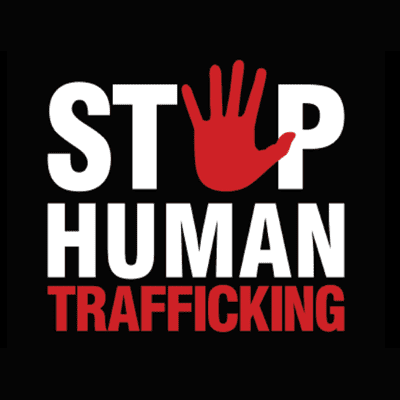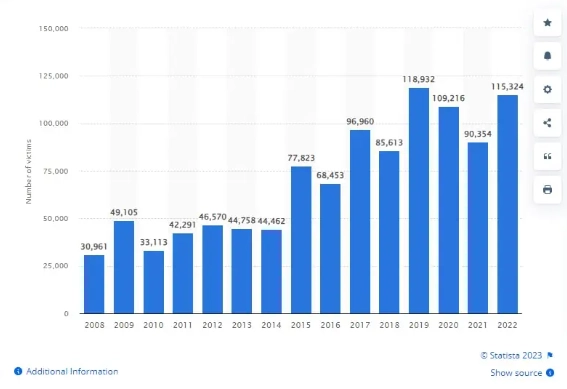If you or someone you know is a victim of human trafficking
Call the National Human Trafficking Hotline at 1-888-373-7888
or text HELP to 233733
Once relegated to back alleys and whispered promises, human trafficking has undergone a chilling digital makeover. Now, in the age of smartphones and social media, traffickers wield technology as a weapon, their nets cast wide across the seemingly harmless terrain of our online lives. This is not just an international scourge; it’s a hidden epidemic thriving right under our noses, fueled by the very information we so readily share.
This all sounds quite bleak, but some of the greatest weapons the public has against human traffickers are knowledge of the practice’s prevalence across the world, how it manifests online, and the steps people can take to make sure they’re never in a situation to be sexually exploited or forced into hard labor.
Knowledge is power. We aim to offer some information here on human trafficking, including what it looks like, the warning signs, and how to effectively fight against traffickers who prey on the vulnerable in society, including young women and children.
Human Trafficking Defined
Human trafficking is often referred to as modern-day slavery. It’s the illegal trading of men, women, or children who are forced to perform exploitative acts, used as the subjects of pornographic content, or are used as forced laborers. It’s a criminal industry that makes millions of dollars each year and involves millions of victims who are held against their will. It’s a problem that persists almost anywhere worldwide, including in the United States.
Human traffickers will typically prey on their victims using deception, blackmail, or straight-up abducting them under the guise of a first date, a job offer, or attending a fake event. Once they’re either captured or have been blackmailed online, the victims lose their freedom and become an object to be bought or sold.
Let’s look at some of the specific types of trafficking that are known to exist. There’s nuance to how victims of human traffickers are commodified. Not everyone who’s trafficked experiences the same horrors as the next person. Being a multi-billion-dollar industry, there are many kinds of exploitation that human trafficking entails.

- Sex Trafficking – This is the type of human trafficking that most people think of when the subject is discussed. This is where victims are subject to work in escort services, their likenesses used in pornographic content, or perform services at brothels. Traffickers call the shots on what they do and benefit financially from their exploitation.
- Child Trafficking – It’s absolutely sickening to think about or discuss, but one of the biggest parts of this industry is child trafficking. Children can be easily tricked and captured, so traffickers take advantage of this and use these victims as forced laborers, subjects for pornography, or sexual exploitation.
- Labor Trafficking – One type of trafficking that many people wouldn’t necessarily think of is forced labor, where victims must work grueling jobs in industries like manufacturing, construction, or agriculture. They are kept in line by threats or blackmail from traffickers.
- Forced Marriage – Women and young girls are usually the victims of this kind of trafficking. They’re forced into marriage with just about anyone, all without their consent. Like other forms of trafficking, coercion, blackmail, or deceit are all tools used to keep them in line.
- Debt Bondage – With debt bondage, individuals must pay off a debt. Still, the traffickers make the terms and conditions of paying off the debt nearly impossible to meet, so you basically have a forced laborer with no conceivable light at the end of the tunnel.
Is Human Trafficking Widespread?
Although nations, law enforcement, and international bodies have put their best foot forward to combat human trafficking across the world, it’s a criminal industry that thrives with every year that goes by. Billions of dollars are made annually from the forced labor, pornographic material, and sexual exploitation that these victims are subject to. Needless to say, this is a widespread, complex issue, and the perpetrators are getting more savvy at rounding up victims and effectively evading the law.
Prevalence Across the World
The United Nations Office on Drugs and Crime did a study on human trafficking, covering 141 countries, to develop a picture of how vast this criminal industry truly is. Considering it’s a covert, underground operation that’s difficult to learn about, some of UNODC’s findings might only be scratching the surface.
Here’s what the report discovered:
- The number of detected human trafficking victims fell in 2020 by 11%.
- This decline appeared, most noticeably, in low- and medium-income countries.
- It’s believed that the chaos of the COVID-19 pandemic might have had law enforcement tied up with other matters and not properly documenting all trafficking reports.
- Global convictions for trafficking crimes dropped by 27% in 2020 as well.
- South Asia saw a 56% decrease.
- Central America and the Caribbean saw a 54% drop.
- South America experienced a dip of 46% in convictions for trafficking crimes.
Victim Escapes Outweigh Police Involvement
The United Nations Office on Drugs and Crime’s report also found that 41% of known victims of human trafficking were those who escaped from their captors and reported to the police or local authorities. By contrast, law enforcement located only 28% of the known victims.
How Chaos Impacts Human Trafficking
The UNODC reports also show an uptick in human trafficking activity whenever there are chaotic events on the world stage. Conflicts like war lead to displaced people groups, which make it easier for traffickers to move in and prey on the vulnerable. For instance, trafficking activity increased in the Middle East and Africa in 2023 following the conflict in Ukraine. When there’s chaos in the air, it is easier to do illegal things and have a large conflict cover it all up.
Trends Through the Years
You’ll see that human trafficking activity rose exponentially between 2008 and 2019, with the number of victims going from 30,000 to 120,000 over the decade. When COVID hit in 2020, and many public spaces were temporarily closed, human trafficking activity ostensibly dropped off as many people were at home during that time, not out and about.

Is the Government Getting Involved?
11 world governments identified a “policy or pattern of human trafficking” in 2023 as per the Trafficking in Persons Report:
- Afghanistan
- Burma
- China
- Cuba
- Eritrea
- Iran
- Korea
- Russia
- South Sudan
- Syria
- Turkmenistan
What this ultimately means is that human trafficking is occurring in spaces where there’s government funding or affiliation. Whether this was common knowledge or was recently discovered by the eleven countries in the report still remains to be seen. It goes to show how widespread this human trafficking ordeal has become in recent years.
Human trafficking in government institutions include:
- Forced labor in medical services that are government-affiliated
- Sexual slavery in government camps
- Sex and labor trafficking government-funded programs
- Recruitment of child soldiers
Is It Easy to Become a Human Trafficking Victim?
While many great things have come from the digital era, where daily life has been made far more convenient and efficient, it’s also become much easier for human traffickers to hone their craft of finding victims. It’s so easy to visit a social media platform like Facebook or Instagram or join a dating app and gain access to someone’s personal information, especially their location.
Recruiting Victims Online
This is becoming common knowledge with the public at this point, a lot of that thanks to the FBI, who have cautioned about human traffickers and how they operate in the online context. Traffickers will use dating apps or social media sites to lure victims into what seem like real events or job offers. Or they’ll create a fake profile and play the part of the new love interest, arrange a meeting time, and nab their victims when the moment is right.
Other Methodologies
To entrap unsuspecting victims, human traffickers will sometimes pose as employers: model agency scouts, job recruiters, or employment agencies. Of course, this is all a farce, a pretext to get victims into a place of vulnerability. These fake employers will present bogus opportunities to lure their next victims.
Another common tactic with human traffickers is to prey on vulnerable people who are experiencing financial hardships, family drama, or other traumatic scenarios. They’ll build trust with their victims by offering emotional support or encouragement. Sometimes, it’s as simple as someone with low self-esteem looking for someone to understand and validate them. This is the entire MO of the trafficker: develop a rapport or emotional bond with someone vulnerable and striking when they least expect it.
Trafficking and Its Prevalence
It’s challenging to get exact numbers on how many human trafficking victims there are (some speculate it’s multi-millions) because it’s such a shadowy, underground affair. Accurate data is hard to come by to indicate how prevalent it is worldwide. Many believe that human trafficking is the third biggest criminal activity internationally. Research has shown that most recruitment takes place online. Unsurprisingly, the industry has grown exponentially over the past few decades thanks to the internet and the willingness of the public to put their data and private information online.
How Traffickers Recruit Their Victims
According to NordVPN, human traffickers use a wide variety of recruitment strategies for preying on the vulnerable. While some of these tactics are as old as time, several strategies have been honed and refined, increasing the level of effectiveness traffickers experience in recruiting their victims.

Catfishing
Because it’s becoming an all-too-common practice with online dating apps and because of the TV show of the same name, many people know of catfishing, the act of creating a fake social media account or profile in the pursuit of luring and entrapping the victim. Catfishes gain the trust of their victims by:
- Using a charming (but fake) profile photo
- Establishing a relationship or rapport based on interests or attraction
- Telling fabricated stories to gain favor or earn trust
- Using flattery to charm their victims
Once the groundwork has been laid, the trafficker will push to meet their victim in person in the hopes of entrapping them. This could be an abduction or full-fledged kidnapping. Sometimes, it could be a threat or blackmail to scare the victim into performing exploitative acts.
We have discovered a useful tool that helps prevent this kind of thing from happening. It’s called Social Catfish. You can read more about it in our Social Catfish review.

Cyberstalking
Traffickers will use technology to track down their victims’ movements using geotags or check-ins on Facebook. Once they know the whereabouts of their victims or have their daily routine down pat, it’s much easier to plan out an abduction. This is why it’s so important not to share too much of your life online because traffickers can cyberstalk you that much easier.

Phishing
This tactic is a bit older than cyberstalking and is all about collecting data, primarily using email to pinpoint a victim’s location. This one is more common with cybercriminals, but traffickers have learned how to use this technology to their advantage over time. They’ll send messages or emails with crooked links that install malware on the user’s device or reveal the victim’s location.

Targeting the Unhappy
The University of Toledo did a study where they studied what kind of people human traffickers typically prey on, going off the nature of their social media posts. They found that a lot of the victims were men, women, or children who were discontented with their circumstances, insecure about their appearance, or felt misunderstood in general. Seeing a window of opportunity to build trust, traffickers will commiserate with or offer encouragement to their victims to get a conversation going and build rapport.

Using IM, Email, Etc.
Communicating with victims using chat functions on a dating app or instant messenger allows traffickers the ability to analyze their victims’ insecurities and come up with a game plan of how to respond, effectively building trust with that person and putting together a strategy to entrap them.

Avoiding Meeting In-Person
In the same study from the University of Toledo, they found that 42% of victims of human traffickers never met the person face-to-face. Because there are some con artists and traffickers who prefer to blackmail or threaten their victims into performing sexual or exploitative acts without even abducting them, many instances involve the trafficker never meeting their victim in real life, preferring to issue directives from the anonymity of the computer screen.
To Catch a Predator- Identifying Human Traffickers
While human traffickers are slick and operate in subtle, sneaky ways to victimize men, women, or children, they resort to using a lot of the same tired (yet effective) tactics for luring their prey. Knowing the tricks and identifying them when they occur takes much of the power away from traffickers who use the same tactics repeatedly..
Look for these common signs of recruitment from human traffickers:
Something That’s Too Good to Be True
- Exclusive access to concerts, parties, or other events where you can enjoy complimentary food, lodging, or accommodations.
- Offers to work for high pay, quick promotion, and short hours. One huge red flag is getting all these with minimal experience in the field or few qualifications.
Few Details Given/Evading Direct Questions
- There’s little information on the event or job—difficulty getting specifics on what’s included with the event or the duties of the job/position.
- When asked direct questions, the trafficker will always give vague answers and will avoid providing verifiable information.
“Sales” Pressure Tactics
- Traffickers will urge victims to commit to a fake job or attend a fake event using high-pressure tactics you see with aggressive salespeople.
- Another common tactic of traffickers is requesting their victims’ immediate reply to their messages.
- Victims are pressured to share private information or photographs.
Poor Communication
- Traffickers will avoid official communication channels, using personal email, texts, or messaging apps.
- They use unprofessional or foul language that does not befit what’s being presented.
- Messages are poorly written (grammar, inconsistent formatting, etc.).
They Ask for Money
- A request for banking information is a strong sign you’re dealing with someone looking to scam or blackmail you.
- Traffickers will act as if they’re in some crisis and request financial help, another common play to get their hands on some money.
- A condition of getting a job is to pay for your training or work attire.
They’re Trying to Get You Alone
- Another common ploy traffickers use is to meet with you in a place that’s off the beaten path or a place that comes off as odd, given the situation.
- They ask you to keep any meetings a secret.
- They want you to sever ties with family, friends, and others in your social network.
Targeting the Vulnerable
- Traffickers are predatory by nature, so it’s not beneath them to approach you when you’re going through personal struggles.
- A big red flag is someone overly concerned with your problems even though you don’t know them well.
- They like targeting victims amid financial hardship, going through relational problems, or who have experienced trauma or loss.
Spam Emails or Offers
- Scammers and traffickers will bombard you with friend requests, job offers, or invitations to events you’re not interested in attending.
- They tend to communicate with you even after you’ve told them you’re not interested in getting to know them or developing the relationship further.
They Invade Your Privacy
- Traffickers will send unwanted images or reveal personal details about themselves that make you feel uncomfortable.
- They will typically request the same from you, looking to gather as much detail as possible about your life without a good reason.
How to Avoid Being a Human Trafficking Victim
To stay safe online and sidestep disaster when it comes to human traffickers and other unsavory online personalities, follow some of the tips, strategies, and best practices listed below:
- Don’t Be Overly Trusting: Stay cautious and vigilant when using social media or online dating apps. Tread carefully with any new people you meet and assume that anyone could be a potential threat.
- Verify Those You Meet Online: Some dating apps or social networking platforms allow members to verify their identity to build transparency and trust.The best-case scenario is to interact with verified members only.If you’re uncertain about anyone you meet, you can check their name with other social media accounts or with a tool like Social Catfish. (see the link to our social catfish review above)
- Don’t Overshare: People online don’t need to know your entire life story or every move you make in your day-to-day life. Be wary of excessively sharing your location or going into a lot of detail about how you spend your time.
- Beware of Catfishing: Assume that anyone you meet online dating could be someone with a fake face and profile information looking to take advantage of you. We’re not saying to be overly paranoid, but know that some people create fake profiles to lure their victims. Dealing only with verified profiles is a great way to deal with legit members.
- Be Careful Where You Click: Avoid phishing scams by not clicking on weird emails or links that appear out of nowhere. Delete these and then alert the police or other authorities so they can get the word out on the scam.
- Make Your Profile Private: Privacy controls on your social media or dating app can allow you to be seen only by your friends or those you choose to interact with. Carefully select only the people you deem legit enough to see your profile.
- Learn About Human Trafficking Tactics: Become aware of the schemes and tricks that traffickers use to lure their prey. If you know how they operate, spotting the red flags when they appear becomes much easier.
- Use Your Intuition: You can’t always trust your judgment because you can be wrong, but avoid anyone your gut tells you isn’t legit. Air on the side of caution; don’t respond to unwanted advances (even to be polite) and pump the brakes on talking or connecting with people online who seem too good to be true.
- Don’t Be Afraid to Contact the Authorities: Anytime you feel threatened or feel you’re becoming the next target of a trafficker, alert the policeor anti-human trafficking organizations that specialize in dealing with this matter. Reaching out to the authorities never hurts, putting traffickers on notice and getting them on the police’s radar.
What to Do if You Suspect You or Someone You Know Is in Danger
If you suspect someone you know or love is the victim of human traffickers, the best thing you can do for them is to act quickly and report the matter to the appropriate authorities. Learn the signs of a human trafficking victim and the steps you can take toward helping them.
What Are the Signs of a Trafficking Victim?
These are the most common signs of someone who’s being coerced or manipulated into sexual/exploitative acts. Someone could be exhibiting all or a few of these behaviors/factors. The situation is different for everyone.
- Signs of physical abuse (black eye, bruises, scars, etc.)
- Odd living conditions
- Weird work hours
- Avoiding eye contact
- Little to no social interaction
- Visibly fearful
- Lack of possessions
- Lack of ID or official documentation
- Scripted responses
- Odd backstories
- Controlling partner or boss
So, now that you’re aware of what a human trafficking victim can look like, it’s best to report the matter to the people who can do something about it.
Record Evidence
- Keep track of any messages or odd conversations you might have had with the victim.
- Take notes on any incidents, screenshots, and times when they occurred.
Don’t Take Matters into Your Own Hands!
- Don’t put yourself in harm’s way by trying to confront the trafficker.
- Call your local law enforcement or the National Human Trafficking Hotline at 888-373-7888. Let the professionals do what they do best and handle the situation.
Call the Police
- For immediate help with a dire situation, call 911, but call local officials if you want to report suspicious activity or something you feel the police should keep an eye on.
- Contacting the police keeps you completely anonymous and out of the crosshairs of anyone who might want to silence you.
Report to the Trafficking Helpline
- You can use this hotline to report suspicious activity or to get help if you’re the one being trafficked, coerced, or blackmailed by a captor.
- Call 1-888-373-7888
- Text HELP to 233733
Provide Information
- Include as many details as possible to help the police/authorities better conduct their search.
Learn More About Human Trafficking
- The more you can learn about human trafficking, the better you can spot the signs and lend a helping hand to the victims of modern-day slavery.
- Share information about human trafficking with friends and family. The more others know about what’s happening, the more eyes and ears there are in your community looking for suspicious activity and warning signs.
Stay in Touch with Victims
- If it’s possible, communicate with anyone you know that you could be a victim of human trafficking. Keep the lines of communication open to show concern or support.
- Share helpful resources with victims like the National Hotline 888-373-7888 or the number where they can text. Text HELP to 233733
Frequently Asked Questions
To get the key highlights of human trafficking, check out some of the most common questions people ask as they learn more about the topic and how they can protect themselves or loved ones. The FAQ section below will cover the basics: how wide-reaching it is, how it shows up online, signs that it’s happening to someone you love, and safety steps you can take to combat those with ill intent.
Human traffic in modern-day slavery. Its victims are exploited for labor or to perform sexual acts. People are lured through violence, manipulation, or the promise of a romantic relationship or a job offer. Unsurprisingly, human traffickers use deceit, force, or coercion tactics to capture millions of men, women, or children each year.
There’s a National Human Trafficking Hotline: 1-888-373-7888. The public can use this to either report suspicious activity or seek help themselves. Other avenues include contacting law enforcement or anti-human trafficking organizations that specialize in fighting for victims, both online and in real life.
Millions of men, women, and children are trafficked each year across the world, including the United States. It’s a significant problem in numerous countries and is typically more common in places with economic hardship, natural disasters, or political instability. Finding and capturing victims is easier when other types of chaos can cover up someone’s disappearance.
Someone you know or have just met may be a victim of human trafficking if there are signs of physical abuse, if they are in a controlling/abusive relationship, or if they avoid interacting with other people. Some trafficking victims will be evasive when answering questions for fear of repercussions from their captors. Other victims have no possessions as they’ve been blackmailed out of what they have.
Some signs of a human trafficker at work include requests for money, a romantic interest love bombing you, high pressure to meet up in real life, getting a job offer that’s too good to be true, or someone who presents a story where information doesn’t line up. Some of these things can be easy to spot, but traffickers can subtly lull you into a false sense of security where it seems like there’s no funny business.
Traffickers will take to social media or dating apps to find their victims. They’ll assume a fake identity and try to build trust (romantic relationships or friendships) with their victims. They’ll use job offers or a possible romantic connection as a pretext to meet in real life. It’s through false promises and deceptive relationships that most human traffickers find and capture their victims.
It’s important to verify the identity of anyone you meet on social media or dating apps. Many sites allow their members to prove their identities, which a checkmark or ribbon will indicate. It’s best to interact only with verified members or users. In general, you want to avoid sharing too much personal information online and only meet up with someone in real life if you can meet in a public place and provide your own transportation.
Human trafficking doesn’t always involve a kidnapping. There are some instances where victims are trafficked online only. In these cases, the victim is usually being blackmailed or threatened into performing pornographic acts or putting themselves in situations where they are exploited.
As with many other crimes, it’s best not to take care of things alone but instead contact law enforcement immediately. There are also human trafficking helplines for additional help and resources. Report any suspicious activity and leave it to the professionals to intervene. Calling the police or a helpline also allows you to maintain anonymity.
• National Hotline 888-373-7888
• Text HELP to 233733
Law enforcement, governments, and other organizations have been working hard to combat human traffickers for many years now, including identifying victims and conducting sting operations to break up trafficking rings. There are public awareness campaigns to teach everyday people about the disturbing truths of trafficking and how they can play a part in fighting against this injustice.
